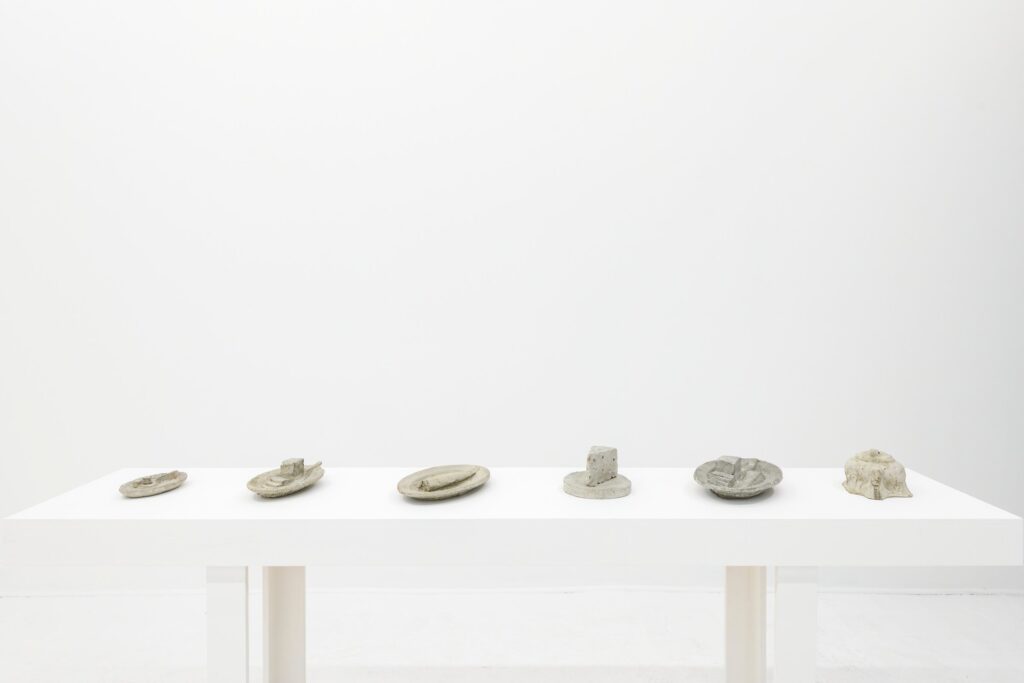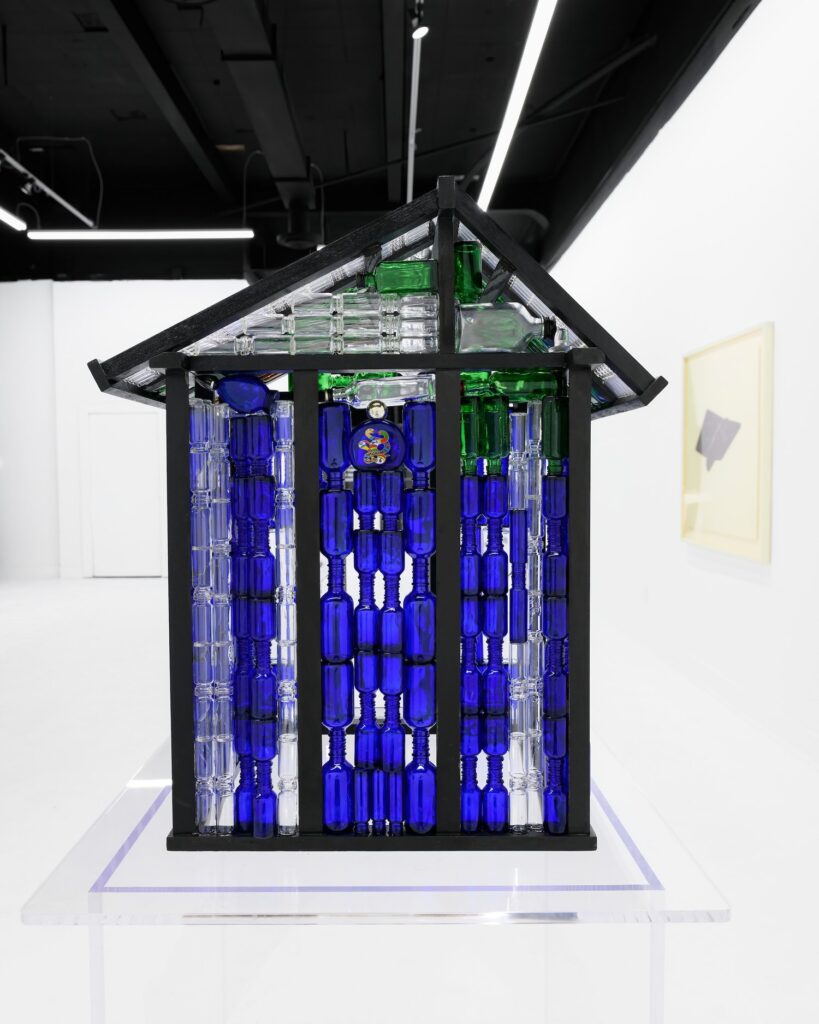At Pt. 2 Gallery in Oakland, “In Conversation with the Muse” (through October 26) features work from six established artists who have strong ties to the Bay Area, working across diverse mediums yet sharing a nuanced sensibility which imbues everyday objects with symbolic weight, and provides plenty to unpack. The group show is in dialogue with a larger set of programming this fall occurring at multiple exhibition venues throughout the city, in recognition of show participant Mildred Howard’s indelible contribution to the arts in the Bay Area and beyond.
The ties between the six artists in the show—Howard, Viola Frey, Martha Shaw, Squeak Carnwath, Robert Therrien, Jay DeFeo—and their ongoing foundational impact on other contemporary artists living in the Bay Area is undeniable. The show functions as an important historical marker of these important figures’ ripple effect in the artistic community.
Several of the artists in the exhibition are best known for making works at monumental scale. Therrien is remembered for his giant tables that make full-grown adults feel like children sulking underneath, Frey for her power/birthday-suited ceramic figures that are larger than life. Not to mention DeFeo’s renowned The Rose—an impasto painting so infamously giant and heavy that they literally had to cut a hole in the side of her Fillmore street apartment to get it out with a crane.
In contrast, many of the works in this show function in smaller proportions, without sacrificing impact or gravitas. The way the works are situated in the space and placed in the gallery poses them as consequential artworks in their own right, rather than as referents or studies related to the larger works.

Still, the concept of the twin (or implied pair) recurs, scaffolded by the layout of Pt. 2’s double-sided gallery. We’re allowed a window into each artist’s development of their own visual lexicon, seeing them chewing on symbols and developing their own language, earthly ties and points of reference to manifest larger ideas. Howard’s bright red glass punctuation marks ( ,_! ) start this conversation by proposing that signs and symbols’ agreed-upon meanings may not be as stable as we’d like to think. It’s the mastication, repetition, and recontextualization of signifiers by artists that allows the transmutation from sign to symbol to metaphor.
A favorite of the exhibition are Therrien’s beards, which are featured in multiple photographic works, as black and white medium format polaroids, depicting the hairy protheses suspended in the studio by hooks on stands. In No Title (two beards in the studio), a shiny white solid beard stands juxtaposed to a gray costume beard that looks like hair but is in fact painstakingly created out of wispy stainless steel wires. The vacuum-formed white plastic prop is presented horizontally on a pedestal in one of the rooms of the exhibition—and it shape-shifts into a sexy, stylized rolling cloud.
In an interview in 2000 Therrien states: “I thought the beard was an interesting subject because it’s a symbol of the artist… At one point, one of the models was Brancusi’s beard, but I eliminated it because it was the wrong shape. Now it’s closer to Rodin’s beard. Didn’t all the great artists have beards?’” Bodily prosthetics with a life of their own, recalling their physical and metaphorical ability to disguise or divert attention—sometimes a beard is more than a beard.
By borrowing from some of the visual principles of animation, reducing elements to their simplest forms, Therrien opens up meaning and allows us to identify with the ostensibly inanimate. But it’s not just pairing down for minimalism’s sake—there’s a narrative and implied significance that you can feel when looking at the work. How much does a horizontal line need to bend in the middle to imply a bird? In what orientation and scale does a common household hinge animate itself and begin to fly away? (See: no title [linear bird], no title [large hinge], and no title [hinge on black]).
Squeak Carnwath’s massive, text-laden paintings (Words Fail Me, Mental Chatter, Please) retain their intimacy with the tender sincere stream of consciousness revealed in handwriting on their layered surfaces. Inside a small black oval floating in a sea of handwritten apologies, Carnwath proposes “We make fictions to understand our feelings and emotions. The remarkable thing is that creativity is not a replica of life but rather a tool for insight. It seems that life chooses our imaginings.”
“Not a replica of life but a tool for insight”—a koan to read this exhibition through, especially as one considers the recurring theme of defamiliarizing quotidian/utilitarian objects in order to understand the world anew.

What if the physical form of those quotidian objects reflected their psychic and metaphorical weight? Martha Shaw’s gray concrete plates are arranged in a row on a narrow plinth with table legs, laden with thick pats of butter, a wedge of hole-y gray cheese fit for a cartoon mouse trap, and stubby utensils all affixed in place. There is a subtlety but also deadpan humor to these extremely-still lives, conjuring intrusive thoughts of cracking ones’ tooth on a concrete sugar cube, or considering the weight of domestic labor made material by the thud of a freshly cooked cement fish passive aggressively slammed on the table. The concrete tea kettle, ostensibly covered to make the casting process easier (less undercuts) becomes obscured and shrouded like a body, a memorial to itself.
The porousness of the material, and all the variations in texture that this process engenders an uncanny quality that forces a reconsideration of the everyday. Shaw is a painter as well, and her beautiful small works found throughout the exhibition with subdued color palates rhyme with the concrete sculptures which somehow skirt the line between dimensions, as if they could be props for a tonal drawing exercise. Shaw’s partner is a ceramic artist who often creates hyperrealistic trompe-l’oeil works, it’s hard not to see Shaw’s plates as a friendly provocation—entering this uncanny valley of things that are reflective of life but exist just outside of it, chiseling out the space where emotion and insight can enter.
Jay DeFeo’s gestural drawings homing in on the joints and details of tripods become metaphors for stability and support, foregrounding a mechanism that mediates much of art production and documentation as subject matter, yet still leaving room for the uncategorizable through omission and decontextualization.

Viola Frey’s series of nine wall-mounted curved plates are more like concave lenses or petri dishes, each an ecosystem. Tactile and dimensional, glaze is resisted in spaces to create silhouettes of oversized hands, doll-like figurines, skeletons and horses in scenes of a play that feel archetypal, such as in Untitled (Skeleton and Horse and Questioning Woman). Several are built up with vibrant colors of glaze globbing, pooling and crazing in cracks that recall an arid topography or landscape of planets unknown to us.
Mildred Howard’s most recent sculpture in her bottle houses series (which started in the 1990s), entitled Blind Thomas Green Colors the World with Sound, is a keystone in this show. Vessels are a recurring motif in Howard’s practice—in this case, small apothecary-sized bottles comprise the architecture of the structure itself between slate-gray wooden supports, functioning as simultaneously as walls, windows, prisms, and “containers for ideas about memory, history, place, and class.”
Each of the houses in this series represent room for reflection about a concept, and have their own significance and antecedents. Based on the title, we might read this house as a container to memorialize the blind piano prodigy Thomas Greene (1849-1908), an enslaved child who taught himself the instrument by the age of five, and could reproduce entire compositions by memory. He was such a dynamic composer and improvisationalist that he toured internationally and was the first Black American musician to perform at the White House, at age 11. Entrenched racism and his master-manager Colonel James Berthune impeded Greene from getting adequate credit or compensation for his work.

Thomas Greene is further invoked elsewhere in this show, a mysterious musical score (Bill Evans’ “Peace piece”?) appears on the walls, only barely visible in glossy white vinyl against the matte white gallery, leading to an ecru grand piano, setting the stage for the future musical performances that will take place in the gallery throughout the run of the exhibition.
In previous interviews, Howard has talked about glass as an “agent of separation,” and it’s interesting to consider spaces’ dualities as both protective and distancing within the context of her sculptural practice. Howard’s tie to the material metaphor also references longstanding Black traditions in which bottles are placed outside the home (often in the form of a bottle tree) as a way to protect the people who live there. Howard cites a passage in James Weldon Johnson’s Autobiography of an Ex-Colored Man, in which the author describes seeing bottles planted neck down in the dirt outside his family’s Georgia home as a child, and wondering if they were growing out of the ground like flowers.
It’s a beautiful visual to picture these metaphors for protection sprouting naturally out of the ground, but in reality these bottle-flowers must be tended to and cared for—something that Mildred Howard has been doing for her entire artistic career, the echoes of this commitment on full display in the exhibition.
IN CONVERSATION WITH THE MUSE runs through October 26 at Pt.2 gallery, Oakland. More info here. The exhibition features live music by Allyson Lovejoy (October 12 at 2pm) and Marcus Shelby (October 19th at 5:30pm). Concurrent exhibitions relating to Mildred Howard’s art practice are also on view this fall at 500 Capp Street and Anglim/Trimble, through October 26.




